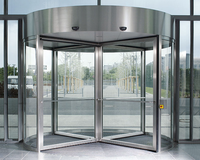








A revolving door is a type of door that, as its name suggests, revolves in its frame.
Most kinds of doors are bolted to the wall and are on hinges. They open only one way, for a theoretical maximum of 180 degrees rotation. Sometimes hinge-doors can open both ways in their frames, for a theoretical maximum of 360 degrees rotation. A revolving door, however, has a theoretical rotation maximum of infinity, as it is set on a rotating shaft.
A revolving door typically consists of three or four doors that hang on a central shaft and rotate around a vertical axis within a cylindrical enclosure. Revolving doors are energy efficient as they prevent drafts (via acting as an airlock), thus preventing increases in the heating or cooling required for the building.At the same time, revolving doors allow large numbers of people to pass in and out.
H. Bockhacker of Berlin was granted German patent DE18349 on December 22, 1881 for "Door without draft of air".
Theophilus Van Kannel, of Philadelphia, was granted US patent 387,571 on August 7, 1888 for a "Storm-Door Structure". The patent drawings filed show a three partition revolving door. The patent describes it as having "three radiating and equidistant wings . . . provided with weather-strips or equivalent means to insure a snug fit". The door "possesses numerous advantages over a hinged-door structure . . .it is perfectly noiseless . . . effectually prevents the entrance of wind, snow, rain or dust . . ." "Moreover, the door cannot be blown open by the wind . . . there is no possibility of collision, and yet persons can pass both in and out at the same time." The patent further lists, "the excluding of noises of the street" as another advantage of the revolving door. It goes on to describe how a partition can be hinged so as to open to allow the passage of long objects through the revolving door. Of note, the patent itself does not use the term "revolving door", though it clearly is.
"In 1889, the Franklin Institute of Philadelphia (the original home of the revolving door) awarded the "John Scott Legacy Medal" to Van Kannel for his contribution to society."